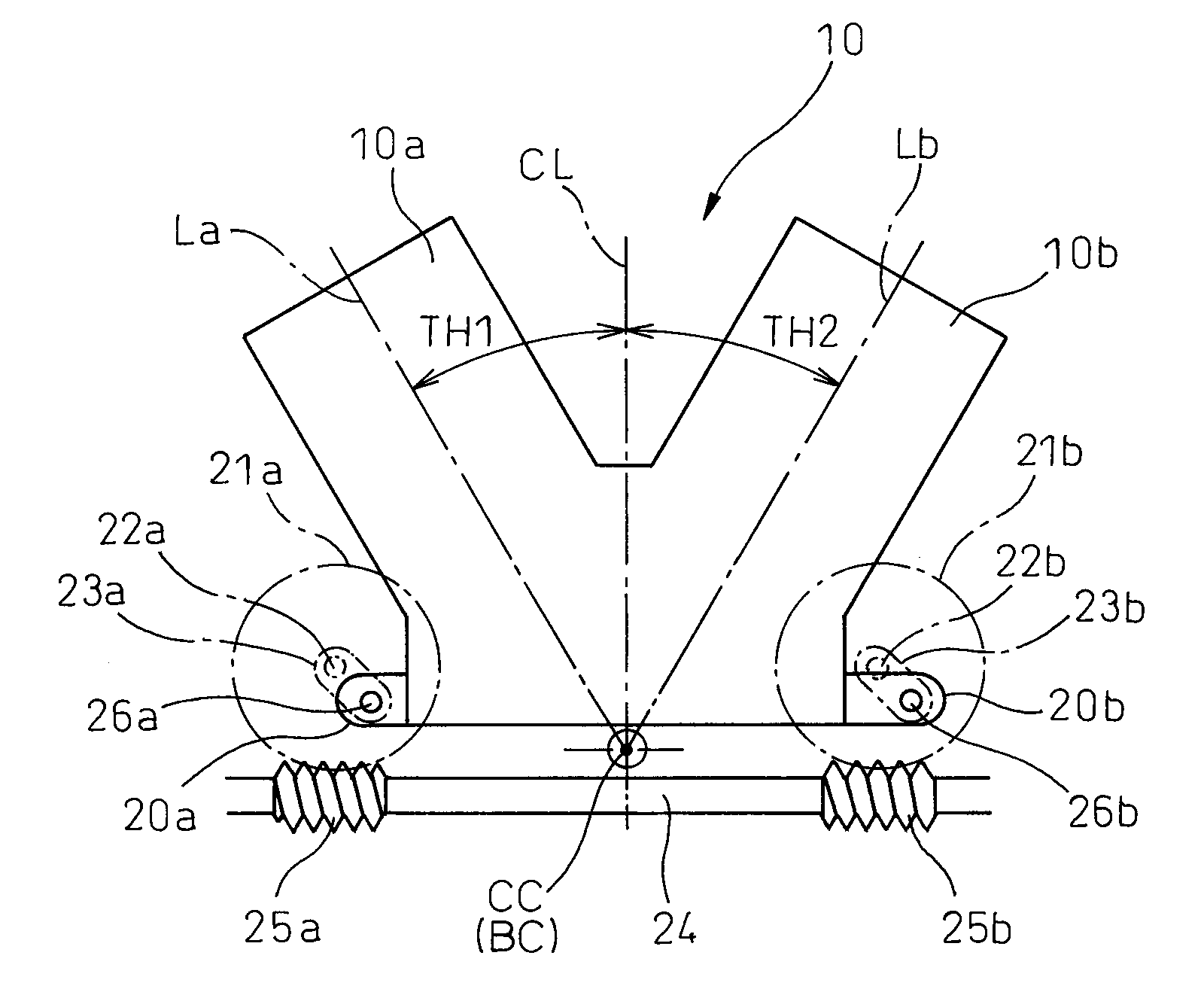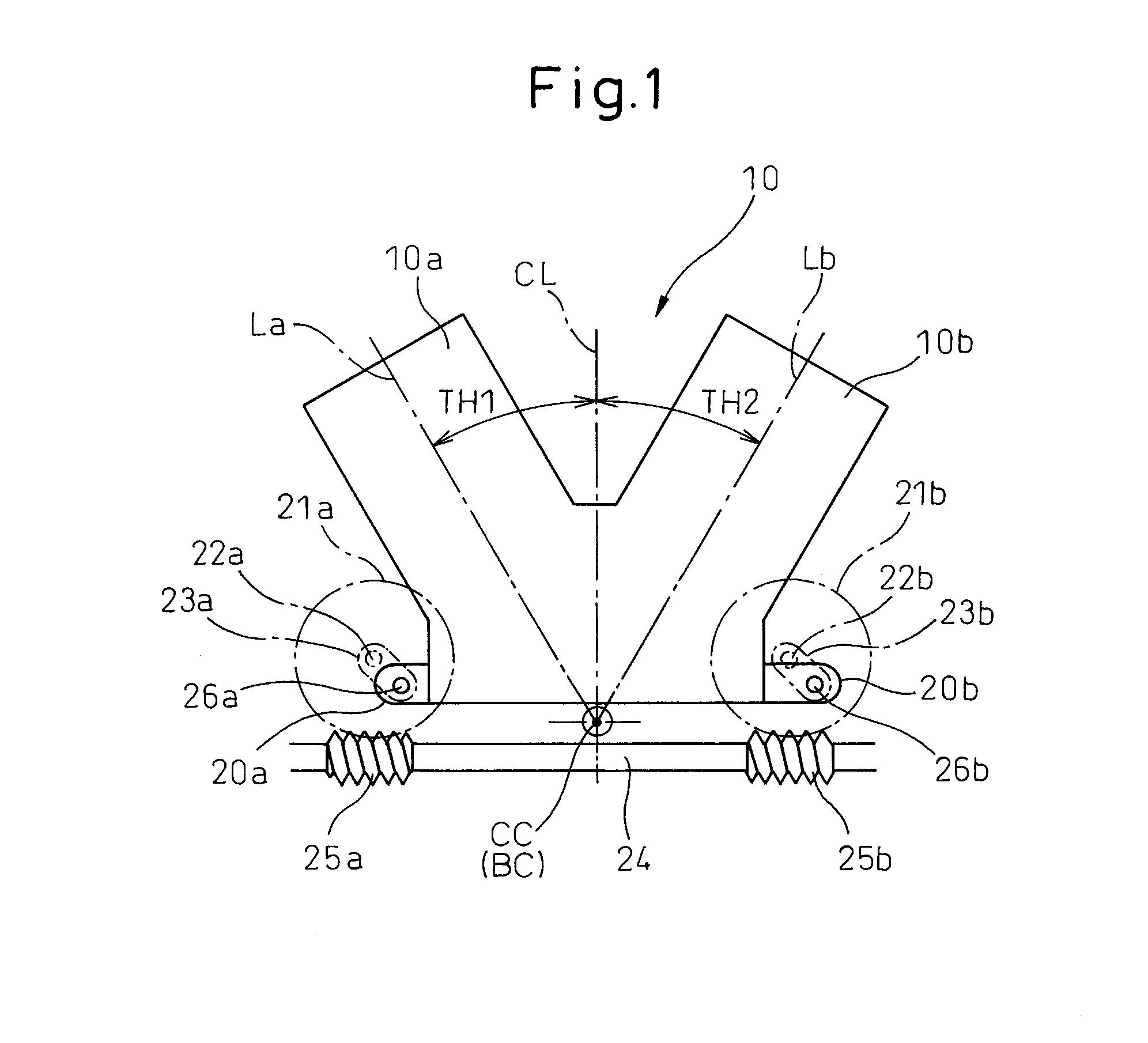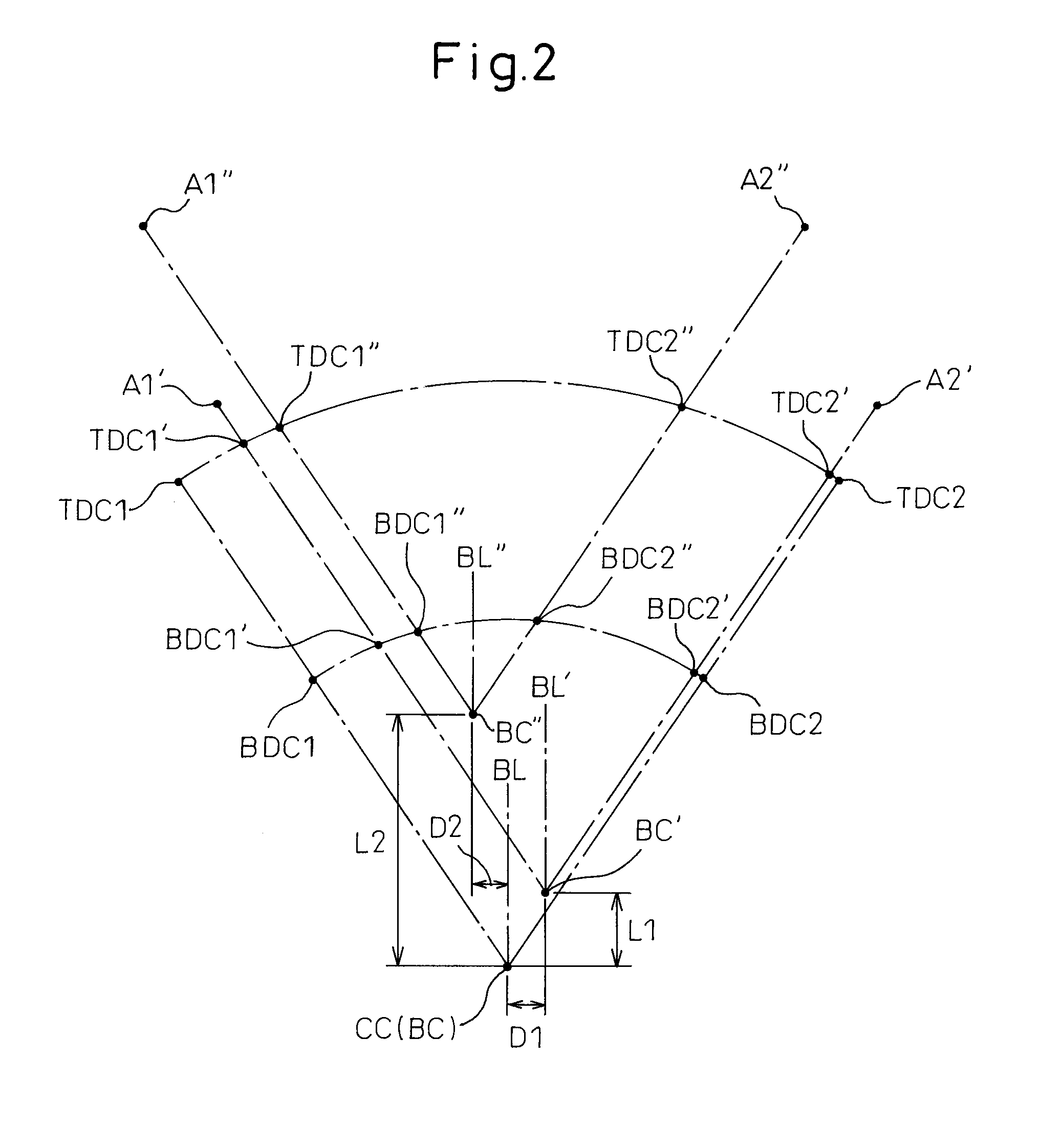[0005]In the above-mentioned variable compression ratio V-type internal
combustion engine, when making the cylinder block move relatively to the crankcase, if the centerline of the cylinder block between the two cylinder groups in the front view accurately matches with the centerline of the engine passing through the center of the crankshaft, at each movement position of the cylinder block, the angle between the centerline of a connecting rod at
top dead center and the centerline of the cylinders in one cylinder group becomes equal to the angle between the centerline of the connecting rod at top dead center and the centerline of the cylinders in the other cylinder group. It is therefore possible to make the mechanical compression ratio of one cylinder group and the mechanical compression ratio of the other cylinder group equal.
[0007]If a large difference in mechanical compression ratios occurs between the two cylinder groups in this way, it is difficult to eliminate the difference in output generated between the two cylinder groups, but if the difference in mechanical compression ratios between the two cylinder groups is small, it is possible to substantially eliminate the difference in output generated in the two cylinder groups by the
ignition timing control or the like.
[0008]Therefore, an object of the present invention is to provide a variable compression ratio V-type internal combustion engine which joins the cylinder blocks of two cylinder groups and makes the joined block move relatively to the crankcase along an arc-shaped path so as to move away from the engine crankshaft wherein the difference in mechanical compression ratios between the two cylinder groups at the different positions of the cylinder blocks is prevented from becoming that great.
[0014]According to the variable compression ratio V-type internal combustion engine as set forth in claim 1 of the present invention, the variable compression ratio V-type internal combustion engine joins cylinder blocks of two cylinder groups and makes the joined cylinder block move relatively to a crankcase along an arc-shaped path so as to move away from an engine crankshaft, the arc-shaped path is set so that the mechanical compression ratio of one cylinder group and the mechanical compression ratio of the other cylinder group become equal when the joined cylinder block is at the lowest position closest to the engine crankshaft and when the joined cylinder block is at a specific position between the lowest position and a highest position which is furthest from the engine crankshaft. As opposed to this, in a general variable compression ratio V-type internal combustion engine, the arc-shaped path is set so that the mechanical compression ratio of one cylinder group and the mechanical compression ratio of the other cylinder group become equal when the cylinder block is at the lowest position and when the cylinder block is at the highest position. Due to this, other than times when the mechanical compression ratio of one cylinder group and the mechanical compression ratio of the other cylinder group become equal, the mechanical compression ratio of one cylinder group always becomes higher than the mechanical compression ratio of the other cylinder group, and the difference between the mechanical compression ratio of one cylinder group and the mechanical compression ratio of the other cylinder group sometimes becomes extremely large. However, according to the variable compression ratio V-type internal combustion engine as set forth in claim 1 according to the present invention, when the cylinder block is between the lowest position and the specific position, the mechanical compression ratio of one cylinder group becomes higher than the mechanical compression ratio of the other cylinder group, but when the cylinder block is between the specific position and the highest position, the mechanical compression ratio of the other cylinder group becomes higher than the mechanical compression ratio of one cylinder group, so the difference between the mechanical compression ratio of one cylinder group and the mechanical compression ratio of the other cylinder group at the different positions of the cylinder block can be prevented from becoming that large.
[0017]According to the variable compression ratio V-type internal combustion engine as set forth in claim 4 of the present invention, in the variable compression ratio V-type internal combustion engine as set forth in any one of claims 1 to 3, when the cylinder block is at the lowest position and when the cylinder block is at the specific position, in the front view, the center axial line of the cylinder block and the engine center axial line which passes through the center of the engine crankshaft match and the mechanical compression ratio of one cylinder group and the mechanical compression ratio of the other cylinder group become equal and the center axial line of the cylinder block when the cylinder block is between the lowest position and the specific position and the center axial line of the cylinder block when the cylinder block is between the specific position and the highest position move away, in the front view, from the engine center axial line to opposite sides from each other. Due to this, when the cylinder block is between the lowest position and the specific position, the mechanical compression ratio of one cylinder group can become higher than the mechanical compression ratio of the other cylinder group, while when the cylinder block is between the specific position and the highest position, the mechanical compression ratio of the other cylinder group can become higher than the mechanical compression ratio of one cylinder group. Thus, the maximum distance separating the center axial line of the cylinder block and the engine center axial line becomes smaller, so it becomes possible to easily prevent the difference in mechanical compression ratios between the two cylinder groups from becoming that large at the different positions of the cylinder block.
[0018]According to the variable compression ratio V-type internal combustion engine as set forth in claim 5 of the present invention, in the variable compression ratio V-type internal combustion engine as set forth in any one of claims 1 to 3, when the cylinder block is at the lowest position, in the front view, the center axial line of the cylinder block has a slant of an
acute angle with respect to the engine center axial line which passes through the center of the engine crankshaft, a first
acute angle between the cylinder center axial line of one cylinder group and the engine center axial line becomes smaller than a second
acute angle between the cylinder center axial line of the other cylinder group and the engine center axial line, the mechanical compression ratio of one cylinder group and the mechanical compression ratio of the other cylinder group are made equal, when the cylinder block moves relatively with respect to the crankcase along the arc-shaped path, in the front view, the cylinder block is made to move in the engine center axial line direction and to move parallel in the other cylinder group side direction from the lowest position, and when the cylinder block is at the specific position, the mechanical compression ratio of one cylinder group and the mechanical compression ratio of the other cylinder group become equal. Due to this, when the cylinder block is between the lowest position and the specific position, the mechanical compression ratio of one cylinder group can become higher than the mechanical compression ratio of the other cylinder group, while when the cylinder block is between the specific position and the highest position, the mechanical compression ratio of the other cylinder group can become higher than the mechanical compression ratio of one cylinder group. Thus, the maximum distance separating the center axial line of the cylinder block and the engine center axial line becomes smaller, so it becomes possible to easily prevent the difference in mechanical compression ratios between the two cylinder groups from becoming that large at the different positions of the cylinder block.
 Login to View More
Login to View More  Login to View More
Login to View More 


